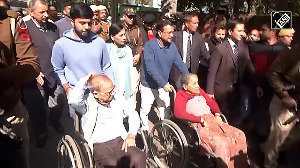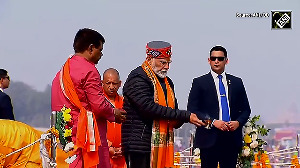Not in its present state of preparedness, rues Subhash Ghai, eminent film producer and director of Mukta Arts, a production company, and Whistling Woods International, an institute for film, television and media arts. "We have huge manpower," he says, "what we don't have is thinkers and creative technicians."
Ghai is especially worried about the capability deficit in the art of storytelling. Young animators are mostly just that - young animators. They need to be dream spinners.
"In a country with a long heritage, with more than 4,000 years of stories, just 2 per cent has been explored so far. We must know how to tell a story, and then use technology," he adds.
Such talent may be scarce, but the animation and gaming industry is brimming with opportunity, domestic and foreign. Even Hindi cinema has started showing a strong inclination for special effects, evident in most recent releases.
Visual effects have worked wonders for many a blockbuster, from Kal Ho Naa Ho, Lagaan and Devdas to Krrish and Kabhi Alvida Naa Kehna.
What's more, India has a significant cost advantage over other outsourcing destinations like Taiwan, China and South Korea. Even as a recent Nasscom report estimates that the Indian animation industry is going to hit $950 million by 2009 from $285 million in 2005, and the gaming industry from $30 million in 2005 to $300 million by 2009, the industry is battling a visible shortage of skilled manpower.
According to industry sources, the animation industry needs about 30,000 people, some six times the current number working in the sector.
"There is a severe lack of training infrastructure for animation in the country," says Pankaj Kedia, a market watcher, "Students coming out of colleges join training institutes. But what happens, after that, to research and specialisation?" He thinks India needs to invite large design studios to set up units in India.
But would that be enough? It is not an easy skill set to develop. Says Sekhar Mukherjee, head of the department, animation, National School of Design, "A good command over animation is not something one can learn from textbooks, but by watching and sharing. The mobile phone we see today was used long ago in James Bond movies, although it looked like a transistor radio. This indicates that animators are highly imaginative and foresee the future much before it comes."
According to Manu Ittinna, leading animator and director of Ittinna Studios, the power of observation is a critical faculty that needs to be empowered. Say, the expression in someone's eyes as he gets up from a chair - it could convey something about the person's intent.
"The animator has to observe all these carefully, and reflect those impulses and emotions in the characters," says Ittinna. Of course, he adds, even after all that detailing, much is left to the viewer's interpretation. "You see what you want to see." That, though, is also why animation is a form of art. What India needs, then, is to stoke the artistic urge.







 © 2025
© 2025